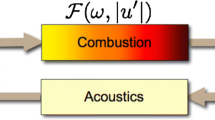Abstract
Intensification of mixing between the gaseous working body ejected through a jet nozzle with ambient medium is an important scientific and technical problem. Effective mixing can increase the total efficiency of power and propulsion apparatuses. The promising approach, although poorly studied, is generation of acoustic self-oscillation inside the jet nozzle: this impact might enhance the decay of a supersonic jet and improve the mixing parameters. The paper presents peculiar properties of acoustic self-excitation in jet nozzle. The paper presents results of experimental study performed for a model injector with a set of plates placed into the flow channel, enabling the excitation of acoustic self-oscillations. The study reveals the regularity of under-expanded supersonic jet decay in submerged space for different flow modes. Experimental data support the efficiency of using the jet nozzle with acoustic self-oscillation in application to the systems of gas fuel supply. Experimental results can be used for designing new power apparatuses for aviation and space industry and for process plants.
Similar content being viewed by others
References
V.S. Zuev and V.S. Makaron, Theory of Direct Jet and Ramjet Engines, Mashinostroenie, Moscow, 1971.
O.V. Guskov and V.I. Kopchenov, Simulation of flow structure in a channel with supersonic inlet conditions, Aeromechanics and Gasdynamics, 2001, No. 1, P. 28-39.
S.I. Baranovsky, V.M. Levin, A.S. Nadvorsky, and A.I. Turishchev, Experimental and theoretical study for co-current supersonic jets with interaction, Int. school-seminar “Turbulent Flows in Interacting Flows”, Minsk, ITMO AS BSSR, 1986, P. 84-98.
V.Yu. Aleksandrov, K.Yu. Arefyev, and A.V. Voronetsky, Study of effective regenerative cooling system in supersonic ramjet engines using hydrocarbon fuel, Teplovye Processy v Tekhnike, 2014, Vol. 6, No. 11, P. 489-495.
V.I. Tsutsuran, N.V. Petrukhin, and S.A. Gusev, Military and Technical Analysis of State of Art and Perspectives in Field of Rocket Fuel, DM RF, Moscow, 1999.
N.P. Dulepov, G.K. Kotenkov, and L.S. Yanovskii, Ramjet with solid fuel, Aktualnye Problemy Aviatsionnyh i Aerokosmicheskih System, 2001, Vol. 6, No. 2, P. 1-21.
S.S. Vorontsov, V.A. Zabaikin, V.V. Pikalov, P.K. Tret’yakov, and N.V. Chugunova, Investigation of the structure of a diffusion hydrogen plume in a supersonic high-enthalpy air jet, Combustion, Explosion and Shock Waves, 1999, Vol. 35, No. 5, P. 465-467.
L.G. Vinogradov, V.L. Semenov, and Yu.M. Shikhman, On 15th anniversary of first flight test of ramjet apparatus fueled by liquid hydrogen, Dvigatel, 2006, Vol. 48, No. 6, P. 28-29.
E.A. Meshcheryakov and V.A. Sabel’nikov, Reduced heat production due to mixing and kinetics factors in supersonic combustion on unmixed gases in an expanding channel, Combustion, Explosion and Shock Waves, 1988, Vol. 24, No. 5, P. 526-533.
A.N. Antonov, V.M. Kuptsov, and V.V. Komarov, Pressure Oscillations in Jets and Separation Flows, Mashinostroenie, Moscow, 1990.
D.A. Gubanov, Impact of microjets on structure and acoustic emission from a supersonic underexpanded jet, PhD thesis, Novosibirsk, 2014.
K.S. Pyankov, Simulation of features of ideal gas flow and two-phase gas-particle mixture, PhD thesis, Moscow, 2011.
M.A. Ilchenko, V.V. Krutchenko, and Yu.S. Mnatsakanyan, Stability of Operation in Aircraft Engines, Mashinostroenie, Moscow, 1995.
V.S. Avduevskii, E.D. Ashratov, A.V. Ivanov, and U.G. Pirumov, Gas Dynamics of Supersonic Nonisobaric Jets, Mashinostroenie, Moscow, 1989.
D.I. Blokhintsev, Acoustics in Nonuniform Moving Medium, Nauka, Moscow, 1981.
E.A. Folomeev, M.A. Ilchenko, and N.I. Selin, Heat transfer intensification in channels under self-oscillations of gas flow, Thermal Engineering, 1995, No. 4, P. 151-159.
G.N. Abramovich, Applied Gas Dynamics, Foreign Technol. Div. Wright-Patterson Air Force Systems Command, Ohio, 1970.
A.S. Ginevskii, E.V. Vlasov, and R.K. Karavosov, Acoustic Control of Turbulent Jets, Fizmatlit, Moscow, 2001.
G. Bendat and A. Piersol, Engineering Application of Correlational and Spectral Analysis, Wiley-Interscience, New York, 1980.
G.I. Eremin and V.I. Kondratyev, Acoustic impact on flow and noise spectrum for supersonic jets, Aero Acoustics, Nauka, Moscow, 1980, P. 119-123.
Author information
Authors and Affiliations
Corresponding author
Rights and permissions
About this article
Cite this article
Aleksandrov, V.Y., Arefyev, K.Y. & Ilchenko, M.A. Experimental investigation of acoustic self-oscillation influence on decay process for underexpanded supersonic jet in submerged space. Thermophys. Aeromech. 23, 513–521 (2016). https://doi.org/10.1134/S0869864316040041
Received:
Revised:
Published:
Issue Date:
DOI: https://doi.org/10.1134/S0869864316040041



